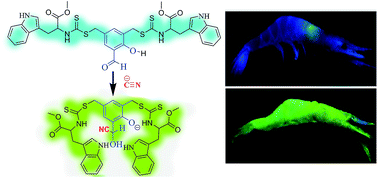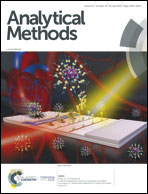Instant detection of cyanide in seafood with a tryptophan based fluorescence probe†
Abstract
The lethal toxicity of cyanide ions to the environment has led to considerable research for the development of rapid and sensitive detection of the ion. Carbonyl compounds are known to readily undergo reactions with CN− to form the corresponding cyanohydrins. Using this chemistry, a bipodal ratiometric probe having thiocarbamate-linked tryptophan units was developed for rapid visual detection of cyanide in seafood. The probe has also been used to visualize the CN− in gel, paper strips and cells with a low detection limit of 2 ppb.



 Please wait while we load your content...
Please wait while we load your content...